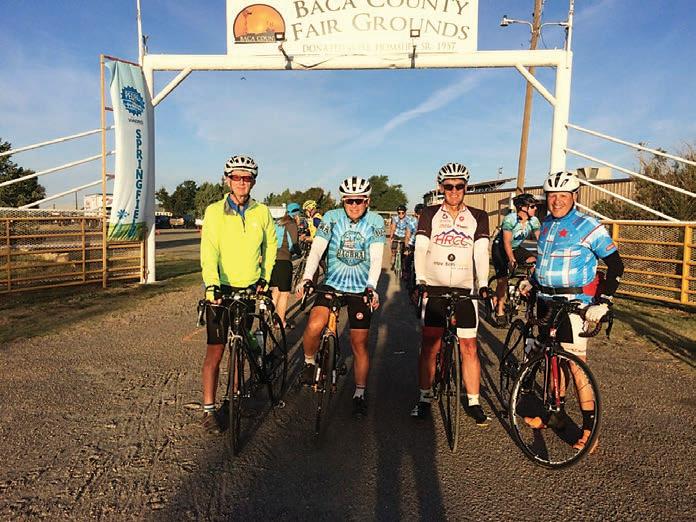
4 minute read
KUMMER
choice for investment of foreign exchange reserves at about 60 percent.
• Some central banks are diversifying holdings away from the dollar and the euro, but only 25 percent of the shift is explained by increased allocations to the Chinese RMB. Much of this was driven by Russia which holds one third of all RMB reserves.
• U.S. sanctions remain on many countries, most notably the freezing of Russian assets after the Ukraine invasion.
• Commodities such as oil are priced and traded in dollars worldwide.
• More foreign currencies are pegged to the U.S. dollar than any other currency including China’s. China is also our largest trading partner with foreign trades pegged to the dollar.
Investment Strategist Brett Lapierre, CFA® states, “I see some weak- what he said,” Frank Ryan, one of Lawful’s friends, wrote in an email to Colorado Community Media.


“David was very gracious and would help anytime I asked. He ‘leaned into’ a friendship and there was no guessing about how David felt.”
After a 40-year career as an aerospace engineer, Lawful retired and gave time back to his community through South Suburban and volunteer work with Bicycle Colorado, a nonpro t that works to make biking safer and more accessible for Coloradans.

“(Lawful’s) attitude was always positive and he showed genuine respect to those with whom he interacted,” Steve Lowry, one of Lawful’s friends, wrote in an email to CCM. “ ere was no hidden agenda with Dave - he was not out for personal gain but only to make the groups he worked with more e cient and productive.”
Joe Westerdale, another friend, said Lawful gave his community “a wonderful example of how to live.”
“When you had a conversation with David, you knew that you always had his full attention and consideration, which may have been why he was so well liked by nearly everyone he came in contact with,” Westerdale wrote. “He was one of the more genuine and unpretentious individuals I have come across in my seventy-one years on this planet.” ness in the USD over the next few years as it is fundamentally overvalued. is, combined with stronger economic growth outside of the U.S., higher interest rates and trade de cit, could all put pressure on the USD. A recession could mean the dollar bounces in the short term in a ight to quality trade but over time, I expect the dollar to weaken.”
A celebration of Lawful’s life will be announced at a later date at https://feldmanmemorial.com/ tribute/details/4734/David-Lawful/ obituary.html.
Memorial contributions are suggested to Bicycle Colorado and e Hudson Gardens Event Center.


Given these facts, the U.S. dollar is alive and well and remains the stronghold currency worldwide. is could change over time as we see improved economic growth in other countries, and as we incorporate more foreign trade.
In our opinion, it is important to make sure your investment portfolio is diversi ed based on your risk tolerance to include investments that can potentially bene t from these economic conditions.
Patricia Kummer has been a Certied Financial Planner professional and a duciary for over 35 years and is managing director for Mariner Wealth Advisors.
April 22, 1941 - March 15, 2023
Michael L. Kudalis was born in Denver, CO on April 22, 1941. First son of Alexander Kudalis and Elizabeth Gri ey Kudalis, the family settled in Englewood, CO. Mike attended Englewood High School, later graduating from Regis High School in 1959.
Michael joined the Marines, attended University of Washington, and chose O cer’s Training in Quantico, VA. From 1967-69 he spent two tours in Vietnam and received a Purple Heart. Returning to the states and enrolling in law school, he graduated from UC Berkeley. Michael then joined the US Coast Guard and practiced martial law for the US Judge Advocate General’s O ce. He retired from the Coast Guard in 1983 as a Lieutenant Commander.
Michael returned to Colorado in 2000. After a few years in the Boulder area, Michael was stricken with Alzheimer’s at the age of 70 but was active, curious and talkative until his death on March 15, 2023. He is survived by two sons, Stephen Kudalis Temecula, CA, and Brian Kudalis Wheat Ridge, CO; a sister Elizabeth James, Trinidad, CO; grandchildren Christopher and Amanda Kudalis (Temecula, CA), and one greatgrandson. Services will be on May 18, 2023, 1:15pm at Ft Logan Cemetery.
BY LUKE ZARZECKI LZARZECKI@COLORADOCOMMUNITYMEDIA.COM
On most Tuesdays and ursdays and some Saturdays, a team of bikers meets to explore Colorado’s network of trails.
e group connects at a co ee shop in downtown Denver. When the weather isn’t too hot, it’s after work around 4 or 5 p.m. In the dead of summer, it’s usually in the morning.
ey sip on espresso and decide where they want to ride that day. It could be on the bike lanes of Denver, the 36 Bikeway to Boulder, the Platte River Trail to Brighton or other suburbs. Most of the time, it involves a stop along the way.
“We would go down the Platte River Trail to the C 470 trail and then Krispy Kremes along there. We call it the Krispy 50. It’s a 50-mile loop,” said Ted Schultz, one of the riders in the group.
e group started after Schultz and two colleagues in his o ce space decided to start riding together after work. Schultz rode with a few others and combined the two groups.
After the ride, they go to a brewery to catch up with one another and relax after the ride.
Colorado’s network of trails
Part of the reason the group exists is due to Colorado’s extensive bike trail infrastructure. Schultz said it’s only improved in the past two decades.
“When you add up the miles of really good trails, it’s just mind-boggling,” he said.

Schultz, who grew up in Colorado, said understanding for cyclists sharing the road and building more infrastructure has vastly grown. In the 70s and 80s, he could almost count on angry driver backlash during his rides. Now, not so much. e Denver Regional Council of Governments built a map that shows all the trails and bike lanes across the region. ey stretch all the way from Boulder to Clear Creek to Castle Rock.
Much of that may be due to more focus on improving trails and streets.
And more may be coming. e Greenhouse Gas Planning Standard, a new rule adopted by the Transportation Commission of Colorado in December 2021, requires agencies to measure greenhouse gas emissions from transit projects, with limits on how high those emissions go.








